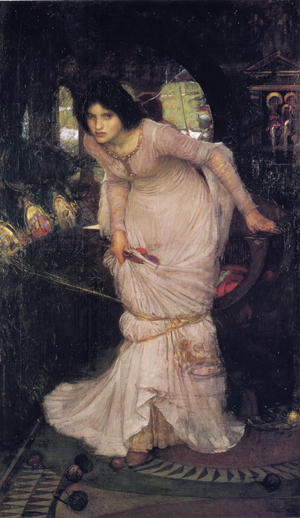|
A popular subject among the Pre-Raphaelite painters, The Lady of Shalott was portrayed both by William Holman Hunt and by John William Waterhouse, among others. The story originally derives from Malory's Le Morte Darthur, where Elaine, the Fair Maid of Ascolat (the more familiar "Astolat" is Caxton's spelling), dies of unrequited love for Lancelot. In Tennyson's poem, the Lady of Shalott is under a curse and must view the world only through a mirror, weaving on her loom "a magic web" of the reflected images that pass outside her castle window. One day, Lancelot rides by on the way to Camelot and she, "half sick of shadows" and stirred by a sexual awakening, turns from the mirror to look at him directly. It cracks and the curse takes effect. The aesthetic between the natural world and the artist's perception of it, the mirrored reflection of both, and their representation in art had a great appeal for the Victorians, as did the perception of the idealized woman as virginal, mysterious, unattainable--and yet desirable. There also is the romanticized pathos of the embowered lady, herself, confined and isolated from the world, and dying in an attempt to experience the love it offers. It is the moment of recognition that Hunt portrays: the lady standing in her loom, entangled in unraveling threads, with the image of Lancelot reflected behind her. Accursed, the Lady goes to the river and floats downstream in a boat, mournfully singing a song. This is the scene illustrated by Waterhouse, conveying all his interest in the affinity of women and water, the erotic undercurrent of martyrdom, and altered states of consciousness. |

|
Waterhouse depicted Tennyson's poem in three different paintings. Here, in The Lady of Shalott (1894), which is in the Leeds Museums and Galleries (England), there is the same guttering candle that was shown in the Lady of 1888, the two images of her tapestry matching those of the earlier picture. Intensely staring at the passing figure of Lancelot, whose image is reflected in the mirror behind her, the lady's needlework, which otherwise symbolizes feminine virtue and domesticity, comes undone, the entangling yarn now representative of her fate.
Reference: J. W. Waterhouse (2002) by Peter Trippi.